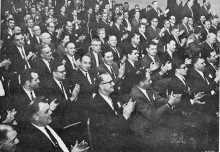Note: Today, I spent National Philanthropy Day with the Mid-Hudson Valley Chapter of the Association of Fundraising Professionals, and served as the luncheon keynote speaker. This post on the challenges of philanthropy is adapted from that speech.
Americans are asked to give – and in fact, do give – more to organized charity than the citizens of any other country. Philanthropy is part of the national DNA and it dates to the time of the Founders and before, when Benjamin Franklin organized the first public charities on this continent. That instinct to both organize and give money to important causes helps to drive much of what we refer to as the nonprofit or social sector. Yet that funding remains both frustratingly small scale and under challenge in an era when the rise of global information networks is shaking up the traditional foundations of civil society.
Think of the challenges that philanthropy is asked to solve. We fight disease, and try to prevent it. We preserve the natural environment. We care for the elderly, the sick, the displaced and the poor. We support the arts and encourage culture. We teach our young, and plan for the future. And of course we support our local communities. Within 25 miles of this room, philanthropy is at work in hospitals, schools, religious organizations, social services, arts, culture, advocacy and research. It?s at work in the preserving of this region?s public resources, from a walking bridge spanning the Hudson to the historic sites connected to the founder of the New Deal. And when a typhoon ravages a country that has a strong immigrant tie to the United States – and what country doesn?t – our society responds, as it did this past week.
It’s everywhere, and for most of the people in this room, the good works that are accomplished in Dutchess, Orange, Putnam, Rockland, Sullivan, and Ulster Counties come with a professional call to service. Our own work has a double bottom line – the family budget, and the impact our jobs have on society. And I know those jobs – and that double bottom line – are increasingly challenging.
Here’s why: giving in the U.S. has stayed level through economic boom times and recessions. It?s always roughly 2% of GDP, and has been since about 1970 when they started collecting these numbers. Yet both the number of nonprofits and the societal burden they are asked to shoulder have grown dramatically.
According to the National Center for Charitable Statistics, between 2001 and 2011, the number of nonprofits in the U.S. increased by 25 percent; from 1.2 million to more than 1.5 million – and it continues to grow. This includes all nonprofits, foundations, and related associations. In terms of the number of enterprises, the growth rate of the nonprofit sector has surpassed the rate of both the business and government sectors.
So as many of you already know, there is more competition for the dollar. And there is more need as well. The privatization of many of government’s functions that began in the 1980s has gradually moved more services from public payrolls to private payrolls. And when they say ‘private’ they’re often referring to charitable enterprises and not businesses. Companies are in the business of handling some of the function government used to, of course, but I don?t think it?s a surprise to find that for-profit organizations zero in on enterprises where profit is possible. That leaves the rest for us.
Meanwhile, our more forward-thinking supporters – Board members, foundations, social investors – ask organizations to be more businesslike, more focused, more strategic – sometimes forgetting that businesses fail at a much higher rate than nonprofits. Yet in many ways they’re right about how the sector operates – we can’t afford to be sleepy and retrograde. The world is changing, people are more connected to information than ever before, and philanthropy is clearly a connected global marketplace. We are asked to be more transparent by our donors and supporters, and we need to be.
To me, this goes beyond being on Facebook or Twitter or taking donations via a smartphone at the annual gala. Those things are great, but they really relate to tactics – and not strategy. When I wrote my book CauseWired five years ago, the idea of networks that allowed fast organizing and online leadership was still relatively new. Now it?s as much a part of the landscape as the Bear Mountain Bridge.
But the strategy around using networks well connects to what so many of us – both old practitioners with some gray hair and bold young change-makers – understand about giving. I tell my nonprofit clients in my consulting practice that every major fundraising effort – from a capital campaign to the gala to a crowdsourced project on Kickstarter – needs four key elements: a strong case for support, committed leadership, prospects for giving, and a plan to get there. I want to boil that formula down to two big take-aways from today, as we think about how our sector moves forward in a networked world – one that is still changing in business, in government, in how we interact on the public commons.


